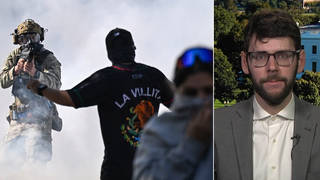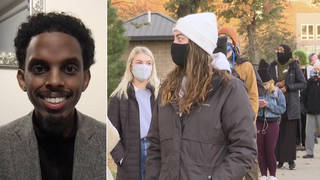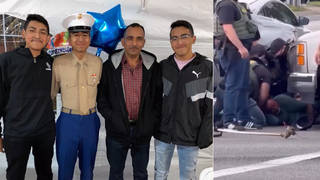
Topics
Guests
- Bernardo Hernández Rojasbrother of Anastasio Hernández Rojas, who was killed in May 2010 while trying to enter the United States from Mexico.
- Roxanna Altholzinternational human rights lawyer and scholar, and associate director of the International Human Rights Law Clinic at UC Berkeley School of Law.
The family of a Mexican immigrant killed by Border Patrol agents in 2010 is launching an unprecedented effort to hold the United States responsible. Six years ago, in May 2010, Anastasio Hernández Rojas tried to cross the border to return to San Diego, where he had lived for 25 years and fathered five children. Hernández Rojas was stopped by Border Patrol agents. He would never see his children again. The agents initially said Hernández Rojas became hostile and resisted arrest, but eyewitness video shows the agents beat and tasered him. The San Diego Coroner’s Office classified Anastasio Hernández Rojas’s death as a homicide, concluding he suffered a heart attack as well as “bruising to his chest, stomach, hips, knees, back, lips, head and eyelids; five broken ribs; and a damaged spine.” Despite these findings, the Department of Justice announced last year there was insufficient evidence to pursue federal criminal civil rights or other federal charges against the agents. Just after our broadcast today, the family of Anastasio Hernández Rojas is filing a petition with the Inter-American Commission on Human Rights in Washington, D.C. We speak to Anastasio’s brother, Bernardo Hernández Rojas, and Roxanna Altholz, associate director at the International Human Rights Law Clinic at UC Berkeley School of Law.
Transcript
JUAN GONZÁLEZ: We turn now to an unprecedented effort to hold the United States responsible for violence committed by its Customs and Border Protection agents. Six years ago, in May 2010, a Mexican immigrant named Anastasio Hernández Rojas tried to cross the border to return to San Diego, where he had lived for 25 years and had fathered five children. He was then stopped by Border Patrol agents. He would never see his children again. The agents initially said Hernández Rojas had become hostile and resisted arrest, but eyewitness video showed the agents had beaten and tasered him. Footage of Hernández Rojas’s death was obtained by reporter John Carlos Frey and aired in a 2012 PBS report by correspondent John Larson.
ANASTASIO HERNÁNDEZ ROJAS: [translated] Please! Señores, help me!
JOHN LARSON: What U.S. border agents did not realize is that eyewitness videos of the incident caught the sounds of Hernández Rojas screaming and pleading for his life.
ANASTASIO HERNÁNDEZ ROJAS: [translated] No! Help!
JOHN LARSON: And now, a never-before-seen eyewitness video of the incident raises new disturbing questions. The dark video reveals more than a dozen U.S. border agents standing over Hernández Rojas. It shows the firing of the Taser. Was Hernández Rojas, as the police press release suggested, combative when he was killed? Or was he on the ground, handcuffed?
JUAN GONZÁLEZ: Video from the PBS program Need to Know. The San Diego Coroner’s Office classified Anastasio Hernández Rojas’s death as a homicide, concluding he suffered a heart attack as well as, quote, “bruising to his chest, stomach, hips, knees, back, lips, head and eyelids; five broken ribs; and a damaged spine.” Despite these findings, the Department of Justice announced last year there was insufficient evidence to pursue federal, criminal, civil rights or other federal charges against the agents.
AMY GOODMAN: Well, today, the family of Anastasio Hernández Rojas is taking another step in their quest for justice. Just after this broadcast, the family is filing a petition with the Inter-American Commission on Human Rights in Washington, D.C.
We’re joined by two guests. Bernardo Hernández Rojas is the brother of Anastasio. And Roxanna Altholz is an associate director at UC Berkeley’s International Human Rights Law Clinic. She is an international human rights lawyer and scholar.
We welcome you both to Democracy Now! Roxanna, let’s start with you. What exactly are you filing today, and what do you hope will come of it?
ROXANNA ALTHOLZ: Good morning. Thank you for having us here today.
We are representing—I’m representing Anastasio’s family in a suit against the United States before the Inter-American Commission on Human Rights. We’re suing the United States for torturing and killing this unarmed father of five. The suit also exposes the problems with the criminal investigation, a criminal investigation that lacked impartiality, that lacked independence. As you mentioned, last year the Department of Justice closed the criminal investigation and found that the Border Patrol had used reasonable force against Anastasio—this despite eyewitness testimony, video and audio that showed that Anastasio was handcuffed in a fetal position on the floor, pleading for his life, surrounded by 15 to 25 border agents, being beaten and tased.
The DOJ’s decision to close the case, in one sense, isn’t surprising, because that criminal investigation was doomed from the beginning. Criminal investigators, police investigators didn’t arrive to the scene until the day after the killing. They allowed Customs [and Border] Protection to have control of the crime scene in the hours—in the crucial hours—after the beating. And the agents dispersed witnesses without recording any of the information. There were over 30 eyewitnesses. They dispersed the witnesses. They seized their cameras, their cellphones, and destroyed images of the beating. And then, when the police investigators finally arrived to the scene, they focused on documenting law enforcement’s version of the events. They did not intend—they did not seek the truth. They did not try to disrupt that narrative, but just document it. So, in the entire police investigation of the more than 30 eyewitnesses, only about three civilians were interviewed and provided statements to the police.
So we are submitting this suit to prevent the U.S. government from sweeping this horrific crime under the rug and to ensure that the United States is held accountable for violence and impunity at the border.
JUAN GONZÁLEZ: Well, I’d like to ask Bernardo Hernández if you could tell us a little bit about your brother and the impact that his death and this failure of the government to act has had on your family.
BERNARDO HERNÁNDEZ ROJAS: [translated] Good morning. My name is Bernardo Hernández Rojas. I am Anastasio’s brother. Anastasio was murdered, he was tortured, on the 28th of May, 2010. Five years have elapsed, and we’ve not found justice. During these five years, we have been fighting for justice, and they have not paid attention to us. That has not been looked into. And this time, we’re here to file with the Inter-American Commission on Human Rights this petition. So it’s to follow up on Anastasio’s case, because this cannot be just left like this—it is an injustice—for, during these five years, we have also met other people who have gone through the same thing, and many very similar things continue to happen at the border. We want this to stop. We want them to stop these injustices. And we want a response from the government as to what’s happening with my brother’s case and why have they not responded with good news.
JUAN GONZÁLEZ: And, Roxanna Altholz, I’d like to ask you: How unprecedented is this action that you’re taking of raising human rights violations with the Inter-American Commission on Human Rights about violations occurring within the United States?
ROXANNA ALTHOLZ: The Inter-American Commission on Human Rights is the only international human rights body with jurisdiction, with the authority to hear an individual complaint against the United States for human rights violations. Victims and advocates have used this, this opportunity, to sue the United States on issues related to the death penalty, on issues related to immigration in the past and on other issues.
We are bringing this suit to draw the international community’s attention to the much-needed—the need for reform, for reform of law enforcement in the United States. I think the Inter-American Commission, in terms of—this is really the bread and butter of the Inter-American Commission. Since the commission was founded decades ago, they have decided dozens and dozens of cases dealing with extrajudicial killings. By filing this suit, we’re creating an opportunity for the Inter-American Commission to bring that expertise, to bring that experience, and join the chorus of voices that have called for law enforcement reform in the United States.
I think it’s a really important opportunity to talk about the kind of structural and legal reform that we need, especially at the border. Since Anastasio’s death, nearly 40—50 more people have been killed. Not a single agent in all of U.S. Border Patrol history has ever been held accountable for one of these killings, has ever been disciplined for one of these killings. As far as we know, all the agents responsible for Anastasio’s death are still on active duty. They have never been disciplined, much less held criminally accountable for the killing.
AMY GOODMAN: There were many videos made of what happened to Anastasio. Ashley Young was another witness who shared the video she recorded on her cellphone of border police. This was shown on the PBS broadcast Need to Know.
ASHLEY YOUNG: He was just screaming, “Help me! Help me! Help me!” in Spanish. His hands were restrained behind his back.
JOHN LARSON: You could tell that his arms were somehow tied together.
ASHLEY YOUNG: Right.
JOHN LARSON: And Young says she only saw him resist once, when officers tried to put him back into the car.
Did he lash out at the officers in any way?
ASHLEY YOUNG: He didn’t. He just kind of forced his feet against the frame of the car, so that he wouldn’t go into the car.
JOHN LARSON: Minutes later, more officers arrive.
ASHLEY YOUNG: Another officer arrived and pulled out a Taser and said, you know, “Stop resisting.”
JOHN LARSON: Was he resisting?
ASHLEY YOUNG: No. The first tase, it was a shock, and people were like, “Why would they do this?” And after the first tase, when he got tased several more times, that’s when people erupted.
JOHN LARSON: That’s when, standing on this overpass with other bystanders, she shoots this.
BYSTANDER: Hey! No!
JOHN LARSON: You can see Hernández Rojas on the ground, surrounded by more than a dozen officers. Need to Know has brightened the video to make it easier to see.
BORDER PATROL OFFICER: Quit resisting.
ASHLEY YOUNG: Oh, my god.
JOHN LARSON: One agent, at the top of the screen, pulls off Hernández Rojas’s pants and walks away with them. But it’s not until a few seconds later, when things appear to calm down, when an officer turns on his light, that we see an agent’s bare leg as he kneels on what appears to be Hernández Rojas’s neck.
ASHLEY YOUNG: The next thing that happened is he stopped moving, and he stopped—I mean, he was convulsing during the tase. And then, after the tase stopped, he just kind of lied there. I think I witnessed someone being murdered.
AMY GOODMAN: In 2012, Democracy Now! spoke to Humberto Navarrete, another eyewitness to U.S. Border Patrol forces beating Anastasio Hernández Rojas on the California side of the U.S.-Mexico border. Navarrete explained how he ended up taking his video of the beating and the tasering of Hernández Rojas.
HUMBERTO NAVARRETE: I was on my way heading to Tijuana. And that’s when I—the first thing that I heard was Anastasio screaming at his top of his lungs, asking for help. And when I got to a more closer area, I saw what just John described: Anastasio face down in handcuffs and two officers in uniform. And there were five officers in the near area right there when I started recording, two uniformed officers. One of them had one of his knees on Anastasio’s neck. The other officer had one—the other knee on Anastasio’s lower back. I started noticing all these details, and the most important thing was that Anastasio was not resisting. And that’s when I decided to pull out my cellphone and start recording what you—what you can see on the first videos. And that’s when I started recording.
AMY GOODMAN: That was Humberto Navarrete. Can you tell us, Bernardo—you’re in Washington; this is a major step in your brother Anastasio’s—in the case of his killing by the U.S. Border Patrol—what you want to come out of this?
BERNARDO HERNÁNDEZ ROJAS: [translated] What I would like to come out of this is that penalties be imposed on the officers, that they stop doing this, that everybody know. Well, it’s already known what happened. But a great many injustices are happening at the border. One of these is my brother’s case, and they have not resolved anything. Something is happening here. The agents don’t want to show their face. It’s not been possible to punish them. They, too, need to uphold the law, like any human being. They need to confront the justice system. If I commit a crime, I need to confront the justice system, and it should be that way for everyone across the board.
JUAN GONZÁLEZ: I wanted to ask Roxanna, in this harrowing video, where we actually see what is, in essence, a mob killing—only a mob in uniform—of Mr. Hernández, in light of all of the debate that we’re hearing in this presidential race about—especially from the Republicans, about tightening border security and also all of the cases that we’ve seen of African Americans killed around the country by law enforcement, your sense of why this issue of abuse of immigrants at the border gets almost no attention these days?
ROXANNA ALTHOLZ: Well, I think it’s part of the vulnerability of border communities and the political rhetoric around border security. You know, border security cannot mean open season on border communities. CBP’s current policies on use of force and accountability foster violence and impunity. A couple weeks ago, a panel of government experts—so the U.S. government recognizes, their own experts—said that the disciplinary system of CBP is so broken that it does nothing to deter abuse. The United States has exponentially increased the budget of CBP since 2001, since 9/11, but has not invested the needed resources to ensure that CBP agents are held accountable for misconduct and abuses. As Bernardo just said, no one should be above the law.
Anastasio also said this, as he pled for his life, as he pled for mercy. He said, “Stop treating me like an animal.” We need to ensure reforms are enacted by CBP that ensure the dignity of all communities at the border, including undocumented migrants, who are some of the most vulnerable, who have real limitations, both practical and legal, to ensuring that they have access to justice. In a sense, these are the individuals, these are the communities that we have to be most careful about protecting, because they are the most vulnerable. And we hope that this suit helps bring these communities into the ongoing, important national dialogue about reform, law enforcement reform.
AMY GOODMAN: Roxanna, we want to thank you for being with us. Roxanna Altholz is associate director at UC Berkeley International Human Rights Law Clinic. And thanks so much to Bernardo Hernández Rojas, the brother of Anastasio Hernández Rojas, who was killed in May of 2010 while trying to enter the United States from Mexico, beaten to death by U.S. Border Patrol agents.
This is Democracy Now! When we come back, President Obama makes a major announcement on dealing with heroin and prescription drug abuse. We’ll have a discussion. Stay with us.
[break]
AMY GOODMAN: “El Hielo/ICE,” La Santa Cecilia, performing here at Democracy Now!'s studios. To see their full performance and interview with them, go to democracynow.org. This is Democracy Now!, democracynow.org, The War and Peace Report. I'm Amy Goodman, with Juan González.












Media Options